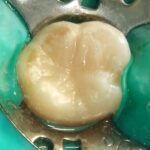
Composite resin restorations are increasingly replacing amalgam for direct restoration of posterior teeth. Owing to volumetric shrinkage during polymerisation composite were place in incremental layers to reduce postoperative sensitivity, microleakage, marginal discoloration, cusp deflection, and marginal gaps. As the incremental approach increases treatment time bulk-fill composite with improved working properties were developed.
The aim of this review was to compare the performance (retention/fracture) of bulk-fill and incremental filled composite restorations place in the posterior teeth of adult patients.
Methods
Searches were conducted in the Medline/PubMed, Cochrane Library, Scopus, Web of Science, Latin American and Caribbean Health Sciences Literature (LILACS), Brazilian Bibliography in Dentistry (BBO), SIGLE, ProQuest, Capes, Current Controlled Trials, International Clinical Trials Registry Platform, ClinicalTrials.gov, ReBEC, and EU Clinical Trials Register databases and International Association for Dental Research (IADR) abstracts from the Annual Session and its regional subgroups (1990–2020). Randomised controlled trials (RCTs) with parallel or split-mouth designs of the clinical performance of posterior composite resin restorations (classes I and II) performed with incremental or bulk-filling techniques in permanent premolars and molars were considered. Two reviewers selected studies and extracted data. Risk of bias was assessed using the Cochrane domains-based tool. For each study, the risk difference (RD) and the 95% confidence interval (CI) were calculated. The meta-analyses were performed on all studies from which the information could be extracted using the random-effects model. Certainty of the evidence was assessed using the Grading of Recommendations: Assessment, Development and Evaluation (GRADE) system.
Results
- 14 studies (4 Parallel, 10 split mouth) were included.
- 1 study only included class I restorations, 6 studies only class II restorations the remainder both class I and II.
- The bulk-fill composite was a full-body (sculptable) resin in 8 studies and a base(flowable) composite in 6 studies.
- 6 studies used rubber dam.
- 4 studies were considered to be at low risk of bias, 7 at unclear risk and 3 at high risk.
- Follow up periods ranged from 7 days to 10 years.
- Meta-analyses showed no difference between the two techniques ( see table).
| No. of studies | Risk difference (95%CI) | |
| Retention/fracture 1-1.5 years | 8 | 0.00 (− 0.01 to 0.01) |
| Retention/fracture 2-3 years | 8 | 0.00 (− 0.02 to 0.02) |
| Retention/fracture 5 or more years | 3 | 0.05 (− 0.08 to 0.18) |
| Postoperative sensitivity up to 30 days | 2 | 0.04 (− 0.02 to 0.10) |
| Postoperative sensitivity 1-1.5 years | 8 | 0.00 (− 0.01 to 0.02) |
| Postoperative sensitivity 2-3 years | 5 | 0.00 (− 0.01 to 0.02) |
Conclusions
The authors concluded: –
the clinical performance of class I and II restorations in posterior teeth is similar when placed with the incremental and bulk-filling techniques, although the quality of evidence was graded as moderate. For all the outcomes evaluated, no significant differences were observed between the restorative techniques, considering short- (up to 3 years) or long-term (5 years or more) follow-up periods.
Comments
The authors registered the protocol for their review on PROSPERO and searched a wide range of databases to identify relevant studies. 14 RCTs were included just 4 of which were considered to be at low risk of bias. The studies involved between 30-72 patients with between 60 and 295 restorations per study. However, the rate of events (failures or postoperative sensitivity) in the included studies was very low, for example in the 3 studies that lasted 5 or more years there were only 20 fractures in total out of 337 fillings. Eleven of the studies included used the modified USPHS criteria to assess outcome and the authors highlight concerns as to whether these are suitably sensitive to assess clinical success although for this review they were dichotomised into alpha (success) vs. bravo/charlie (failure). A majority of the included studies were of a split mouth design which although efficient require appropriate analyses. Overall while the findings suggest that there is little difference between the two techniques larger trials that are well designed, well conducted and reported and conducted in a primary care setting would be helpful.
Links
Primary Paper
Kunz PVM, Wambier LM, Kaizer MDR, Correr GM, Reis A, Gonzaga CC. Is the clinical performance of composite resin restorations in posterior teeth similar if restored with incremental or bulk-filling techniques? A systematic review and meta-analysis. Clin Oral Investig. 2022 Jan 15. doi: 10.1007/s00784-021-04337-1. Epub ahead of print. PMID: 35031879.
Other references
Dental Elf – 23rd Aug 2021
Composite resin or amalgam fillings for permanent posterior teeth
Dental Elf – 21st Sep 2016
Composite restorations: no difference in longevity with direct or indirect placement
Dental Elf – 14th Jul 2014
Picture Credits
By Albert – Own work, CC BY-SA 3.0
